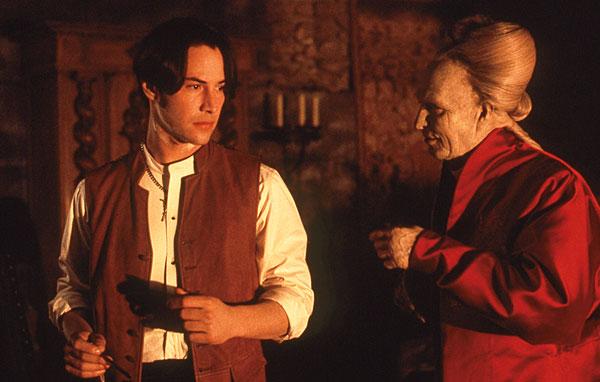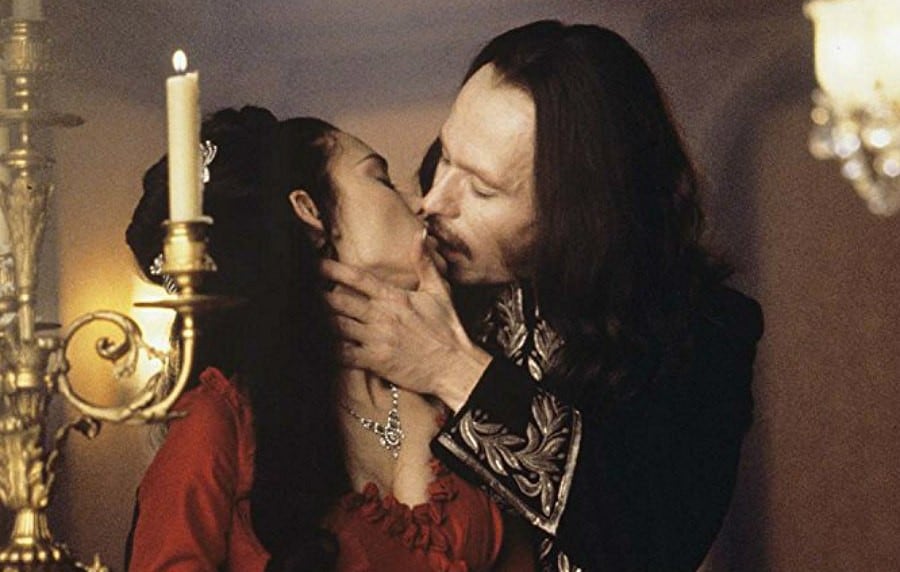Every month, we at The Spool select a filmmaker to explore in greater depth — their themes, their deeper concerns, how their works chart the history of cinema, and the filmmaker’s own biography. For April, we revisit both the game-changing hits and low point misses of Francis Ford Coppola. Read the rest of our coverage here.
So there’s this fabulous sequence about three quarters of the way through Bram Stoker’s Dracula where nearly all the characters left alive are speeding to Transylvania and Dracula’s castle for the film’s climax. On one side of the race are Professor Abraham Van Helsing (Anthony Hopkins) , barrister Jonathan Harker (Keanu Reeves), his fiancée Mina Murray (Winona Ryder), and three adventurers/friends.
On the other is Dracula himself (Gary Oldman), and his minions. Dracula needs to return to his castle to sleep and regenerate in soil from his homeland, which is apparently a thing vampires need to do; the others are trying to beat him there in order to destroy him once and for all. In so doing, they can release Mina from the vampire curse she received when Dracula fed from her, and allowed her to feed from him in return.
Dracula travels on a big, black, foreboding ship that sails through icy, dark waters beneath grey sunless skies. Meanwhile, the heroes travel across Europe in a private train car, forming desperate, last ditch plans in their lush carriage. And through it all, Mina lies sick, facing a fate far worse than death if they should fail. Francis Ford Coppola throws everything he has at the sequence; fades, dissolves, overlapping dialogue, narration, text on screen, and that awesome thing where you show a map and then have little dots showing the progress the characters are making.
All the while composer Wojciech Kilar’s score builds from low and ominous to full on operatic cataclysm. Scenes and sounds and characters and voices all run into and through each other into this fabulously unsettling tapestry of dread and horror. It feels like a journey into the mouth of hell.

It is, as previously stated, a truly fabulous sequence that does a wonderful job ramping up the tension and setting the stage for the climax of the film. But what it’s not, is a particularly standout set piece from the film the way say, the Ride of the Valkyries attack from Apocalypse Now stands out, or Michael killing Captain McCluskey in The Godfather. It’s just a sequence that exists to connect one part of the movie to the other.
So why bring it up?
Because it’s fucking great, and it perfectly demonstrates why the movie is so special; because it’s giving a hundred and ten percent for every second of its running time. Bram Stoker’s Dracula isn’t an especially deep or significant movie and, considering its pedigree, was met with tepid reviews when it was released. It wasn’t that it was bad so much as a filmmaker of such talent should be aiming higher than another Dracula story. According to the ever reliable internet, Dracula has appeared on screen over two hundred times since 1922; sure, Coppola wasn’t cranking out stone cold classics like he’d been in the 70’s anymore, but he was still better than a silly horror movie. The feeling at the time was, let Coppola make his vampire picture then he can get back to making important movies again.
But Coppola is, above all else, a megalomaniacal ham, and when he decides to do something, he does it. With Bram Stoker’s Dracula he set out to make the Dracula picture to end all Dracula pictures, the granddaddy of them all, the ultimate expression of the myth’s operatic, gothic, grandeur and by God (a few shaky accents aside) he succeeded. Every moment of the film is designed within an inch of its life and planned out to maximize its impact on the audience. Coppola had every shot storyboarded, then animated the drawings and spliced in footage from Cocteau’s Beauty and the Beast and paintings by Gustav Klimt to give designers a feel for what he wanted. He gathered the cast together and had them read the entire Stoker novel aloud together over a period of two days.

Determined to use only on-set, in-camera effects that were more period appropriate, he fired the visual effects crew who insisted that modern computer effects were necessary to achieve his vision, and replaced them with a crew headed by his son Roman. They relied on models, matte paintings, forced perspective, rear projection and double exposure and the result is a film that looks like no other. The blending of modern aesthetics, and performances with such antiquated techniques keeps you unbalanced in weird ways because part of your mind is watching an old timey horror movie and the other is watching something very modern.
To that point, Bram Stoker’s Dracula is almost comically vulgar. Dracula becomes a vampire by stabbing a statue of Jesus and drinking from the geyser of blood that bursts (ejaculates?) forth while a bunch of horrified monks look on. A woman is decapitated and as her head flies through the air, the film abruptly cuts to a dinner table and a serving plate of sliced-up roast beef. Renfield crouches in a dank, moldy asylum cell, muttering and feeding on spiders and centipedes. And when Dracula’s wives feed on poor Harker, they focus on his stomach and groin, in a less than subtle fellatio metaphor. While the film’s sex content doesn’t manage to keep pace with its gore, it still drapes the film in a hazy sensuality that saturates the grime and gore and makes it all the more unsettling. Coppola told his collaborators he wanted the movie to be an erotic nightmare, and that’s as apt a description of the film as can be made.
Everything about Bram Stoker’s Dracula is opulent and ornate, winning Oscars for costume design, makeup and sound effects editing, and nominated for art direction. Why it wasn’t nominated for production design and cinematography remains a mystery. The score is suffused with the kind of bombast that achieved a life beyond the film–even if you’ve never seen the movie itself you’ve heard pieces of the score in 90’s era trailers for movies like Schindler’s List, 12 Monkeys, and the Mummy and Underworld series.
With Bram Stoker’s Dracula [Coppola] set out to make the Dracula picture to end all Dracula pictures
And the performances, oh man. Gary Oldman is iconic as Dracula; frightening, tragic, romantic, hideous, hilarious, and monstrous, he hits every note perfectly. Fresh off his own Oscar, Anthony Hopkins tackles Van Helsing with a wild eyed zeal that screams “I can’t believe they’re letting me get away with this” and a Eastern European accent that seems constructed solely from B movies he caught on late-night TV. Speaking of accents, Winona Ryder and Keanu Reeves fare less well with their accents, as well as with their parts in general. They’re like two sputtering lighters in a world filled with eruptions of hellfire. But even their shakiness sort of works to the movie’s advantage, because how can their chaste love survive in the face of the operatic sex and violence that surrounds it? Richard E. Grant, Cary Elwes and Billy Campbell all put in solid matinee idol work as three adventurers determined to bring Dracula to justice. And as Renfield, Tom Waits finally answers the age old question: “What if Renfield from Dracula looked and behaved exactly like Tom Waits?”
It’s all bound up together, the performances, the effects, the costumes and sets and music into a glorious jewel of a film that has no other purpose other than to be singular and beautiful and entertaining. It’s a bunch of professionals busting their asses to provide a fun ride for the audience. Which brings us back to that train sequence. Like the train sequence, Bram Stoker’s Dracula isn’t one of the showstoppers in Coppola’s oeuvre. It’s not one of the movies that’s gonna get listed in the first paragraph of his obituary. It didn’t win any of the primary performers their Oscars, and, outside maybe of Oldman, it’s not the first movie anyone will think of when their names come up.
It’s a movie that exists in between other movies the same way that sequence exists to connect one act of the film to the next. But, also like that sequence, everyone involved is giving a hundred and ten percent and just because it’s a minor moment between other things, that doesn’t mean it shouldn’t be fucking great.